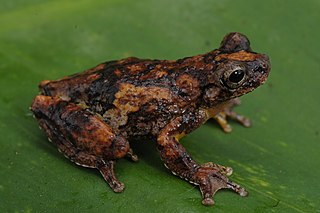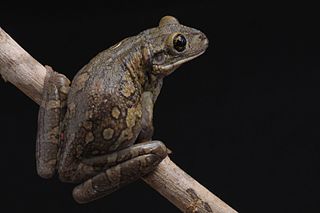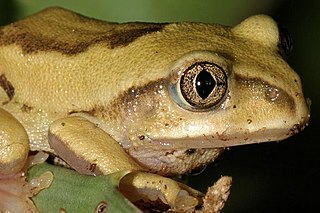
Dendropsophus seniculus is a species of frog in the family Hylidae. It is endemic to Brazil. Its natural habitats are subtropical or tropical moist lowland forests, swamps, freshwater marshes, intermittent freshwater marshes, and rural gardens. It is threatened by habitat loss.

The black-spotted casque-headed tree frog is a species of frog in the family Hylidae endemic to Brazil. Its natural habitats are subtropical or tropical moist lowland forests, subtropical or tropical moist shrubland, freshwater lakes, intermittent freshwater lakes, freshwater marshes, intermittent freshwater marshes, rural gardens, and heavily degraded former forests. It is threatened by habitat loss.

Leptopelis mossambicus, the brown-backed tree frog, Mozambique tree frog or Mossambique forest treefrog, is a species of frog in the family Arthroleptidae found in Malawi, Mozambique, South Africa, Swaziland, Zimbabwe, and possibly Botswana. Its natural habitats are dry savanna, moist savanna, subtropical or tropical moist shrubland, subtropical or tropical dry lowland grasslands, subtropical or tropical seasonally wet or flooded lowland grasslands, swamps, freshwater marshes, and intermittent freshwater marshes. It is threatened by habitat loss.
The long-toed tree frog is a species of frog in the family Arthroleptidae found in South Africa and possibly Lesotho. Its natural habitats are temperate grassland, swamps, freshwater marshes, and intermittent freshwater marshes.
Ptychadena cooperi is a species of frog in the family Ptychadenidae. It is endemic to Ethiopia.
Ptychadena erlangeri is a species of frog in the family Ptychadenidae. It is endemic to Ethiopia.
Ptychadena gansi is a species of frog in the family Ptychadenidae. It is endemic to Somalia.

Pseudagrion is the largest genus of damselfly in the family Coenagrionidae, with over 140 species. Its range includes most of Africa, much of Asia, and Australia. Africa holds most of the diversity with almost 100 species. It has occupied most of the freshwater habitats in its range, and dominates damselfly communities in habitats as different as desert pools, equatorial rainforests and montane streams.
Pseudagrion assegaii is a species of damselfly in the family Coenagrionidae. It is found in Botswana, Namibia, South Africa, Uganda, Zambia, and Zimbabwe.

Pseudagrion coeleste is a species of damselfly in family Coenagrionidae.
Pseudagrion guichardi is a species of damselfly in the family Coenagrionidae. It is endemic to Ethiopia. Its natural habitats are subtropical or tropical moist montane forests and rivers. It is threatened by habitat loss.
Pseudagrion kaffinum is a species of damselfly in the family Coenagrionidae. It is endemic to Ethiopia. Its natural habitat is rivers.
Pseudagrion lindicum is a species of damselfly in the family Coenagrionidae. It is found in Kenya, Mozambique, Somalia, Tanzania, and possibly Uganda. Its natural habitats are subtropical or tropical moist lowland forests, subtropical or tropical dry shrubland, subtropical or tropical moist shrubland, rivers, intermittent rivers, freshwater marshes, and intermittent freshwater marshes.

Pseudagrion massaicum is a species of damselfly in the family Coenagrionidae. It is found in Angola, Botswana, Comoros, the Democratic Republic of the Congo, Ethiopia, Ghana, Kenya, Malawi, Namibia, Somalia, South Africa, Sudan, Tanzania, Uganda, Zambia, Zimbabwe, possibly Burundi, and possibly Guinea. Its natural habitats are subtropical or tropical moist lowland forests, dry savanna, moist savanna, subtropical or tropical dry shrubland, subtropical or tropical moist shrubland, rivers, intermittent freshwater lakes, and freshwater marshes.

Pseudagrion newtoni, the harlequin sprite, is a species of damselfly in the family Coenagrionidae.
Pseudagrion nubicum, also known as the Bluetail Sprite, is a species of damselfly in the family Coenagrionidae. It is found in Benin, Botswana, Burkina Faso, Cameroon, Chad, the Democratic Republic of the Congo, Ivory Coast, Egypt, Ethiopia, Gambia, Ghana, Kenya, Malawi, Mali, Namibia, Niger, Nigeria, Senegal, Sierra Leone, Sudan, Tanzania, Togo, Uganda, Zambia, Zimbabwe, and possibly Burundi. Its natural habitats are swamps, freshwater lakes, intermittent freshwater lakes, freshwater marshes, and intermittent freshwater marshes.
Pseudagrion rufocinctum is a species of damselfly in the family Coenagrionidae. It is found in the Democratic Republic of the Congo, Tanzania, and Uganda. Its natural habitats are subtropical or tropical moist lowland forests and freshwater springs. It is threatened by habitat loss.

Pseudagrion sudanicum, the blue-sided sprite is a species of damselfly in the family Coenagrionidae. It is found in Botswana, the Democratic Republic of the Congo, Gambia, Ghana, Malawi, Mozambique, Namibia, Nigeria, South Africa, Sudan, Uganda, Zambia, and Zimbabwe. Its natural habitats are intermittent rivers and freshwater marshes.
Pseudagrion superbum is a species of damselfly in the family Coenagrionidae. It is endemic to the Democratic Republic of the Congo. Its natural habitat is rivers.
Pseudagrion torridum is a species of damselfly in the family Coenagrionidae. It is found in Burkina Faso, Ivory Coast, Egypt, Ethiopia, Ghana, Guinea, Kenya, Mali, Nigeria, Senegal, Sudan, Tanzania, Uganda, and Zambia. Its natural habitats are freshwater lakes and freshwater marshes.








